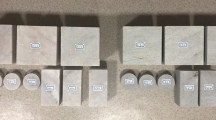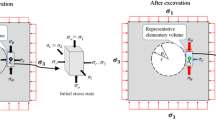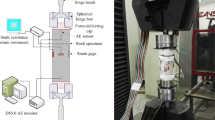Abstract
We show that simple breakage of a crystalline rock (gabbro) in tension begets further breakage of rock in the area around the first crack that is self-sustaining and spontaneous and that is detected via sustained acoustic emissions (AE). The result is a sequence of AE events that is statistically similar to aftershocks from earthquakes, that scales with the size of the main crack, and that we were able to observe for days following the initial breakage in laboratory-scale experiments. A new model for aftershock generation that is based on residual strain relaxation is shown to be consistent with the observed hyperbolic decay of the event rate with time and with the manner in which the decay law scales with the size of the main rupture.








Similar content being viewed by others
References
Applied Seismology Consultants (2010) Insite seismic processor users manual version 2.14d. www.appliedseismology.com
Baró J, Corral A, Illa X, Planes A, Salje EKH, Schranz W, Soto-Parra DE, Vives E (2013) Statistical similarity between the compression of a porous material and earthquakes. Phys Rev Lett 110(8):088702
Botvina LR (1999) On correlation of various approaches for description of kinetic processes. Int J Fract 99(1–2):131–141
Bunger AP, Kear J, Dyskin AV, Pasternak E (2014) Interpreting post-injection acoustic emission in laboratory hydraulic fracturing experiments. In: Proceedings 48th U.S. rock mechanics symposium, Minneapolis, MN, USA, 1–4 June 2014. Paper No. 14–6973
Chitrala Y, Moreno C, Sondergeld C, Rai C (2011) Microseismic and microscopic analysis of laboratory induced hydraulic fractures. In: Proceedings Canadian unconventional resources conference, Calgary, Alberta, Canada, 15–17 Nov 2011. SPE 147321
Davidsen J, Stanchits S, Dresen G (2007) Scaling and universality in rock fracture. Phys Rev Lett 98(12):125502
Geiger L (1910) Herdbestimmung bei erbeben aus den ankunftszeiten. K Gesell Wiss Gott 4:331–349
Goebel THW, Becker TW, Schorlemmer D, Stanchits S, Sammis C, Rybacki E, Dresen G (2012) Identifying fault heterogeneity through map** spatial anomalies in acoustic emission statistics. J Geophys Res 117:B03310
Gutenberg B, Richter CF (1954) Seismicity of the earth and associated phenomena, 2nd edn. Princeton University Press, Princeton
Gy R (2003) Stress corrosion of silicate glass: a review. J Non-Cryst Solids 316(1):1–11
Hardy HR Jr (1972) Application of acoustic emission techniques to rock mechanics research. Acoust Emiss ASTM STP 505:41–83
Kranz RL (1983) Microcracks in rocks: a review. Tectonophysics 100(1):449–480
Kuksenko V, Tomilin N, Damaskinskaya E, Lockner D (1996) A two-stage model of fracture of rocks. Pure Appl Geophys 146(2):253–263
Lockner D (1993) The role of acoustic emission in the study of rock fracture. Int J Rock Mech Min Sci 30(7):883–899
Omori F (1894) On the aftershocks of earthquakes. J Coll Sci Imp Univ Tokyo 7:111–200
Salganik RL (1973) Mechanics of bodies with many cracks. Mech Solids 8(4):149–158
Scholz CH (1968) Microfractures, aftershocks, and seismicity. Bull Seismol Soc Am 58(3):1117–1130
Shcherbakov R, Turcotte DL, Rundle JB (2004) A generalized Omori’s law for earthquake aftershock decay. Geophys Res Lett 31:L11613
Utsu T (1961) A statistical study of the occurrence of aftershocks. Geophys Mag 30:521–605
Zhurkov SN (1984) Kinetic concept of the strength of solids. Int J Fract 26(4):295–307
Zietlow WK, Labuz JF (1998) Measurement of the intrinsic process zone in rock using acoustic emmission. Int J Rock Mech Min Sci 35(3):291–299
Acknowledgments
This work was funded by the Commonwealth Scientific and Industrial Research Organisation (CSIRO). We are grateful to Rob Jeffrey for his support, constructive comments, and participation in this experimental program and the discussions it has generated.
Author information
Authors and Affiliations
Corresponding author
Appendices
Appendix 1: Additional experimental data
The main article presents a selection of the experimental data. In its support, we here provide a compendium of data from the experiments.
Figure 9 gives the evolution of injection pressure (hydraulic fracturing experiment) or loading force (notched beam experiments) along with cumulative AE events for the experiments not included in the main article. Consistent with the data in the main article, we observe AE prior to peak pressure, during hydraulic fracture propagation, and after fracture propagation ceases with an increase in aftershock frequency coming after the injection ceases and the fluid pressure is released.
Evolution of injection pressure (hydraulic fracturing experiment) or loading force (notched beam experiments) along with cumulative AE events for the experiments not included in the main body of the paper. For clarity, only the first 6000 s after peak pressure/load is shown. Open circles superimposed on the pressure record correspond to AE events and the vertical dashed line corresponds to shut-in (isolation from the injection system) for the hydraulic fracturing experiments and the point where the two halves of the beam were separated and placed on a benchtop for the notched beam experiments. a Hydraulic fracturing experiment 2, where the point indicated by the asterisk (*) corresponds to the first event, subsequent tightening of the fitting resulting in a slight pressure decrease, and continued pressurization with a reduction of the injection rate from 1 to 0.2 ml/min. b Hydraulic fracturing experiment 3, which was performed in the same block and 20 mm above experiment 2. c Notched beam experiment 2
Figure 10 presents cumulative post unloading events versus the shifted time since unloading along with best-fit prediction based on frequency decay following the Omori law for the experiments not included in the main body of the paper. The observations are consistent with Fig. 7 in the main article, namely: (1) aftershocks for both types of experiments follow an Omori’s law frequency decay, (2) for the hydraulic fracturing experiments, we consistently obtain a change in slope at about 1000 s after shut-in and pressure relief.
Cumulative post unloading events versus the shifted time since unloading along with best-fit prediction based on frequency decay following the Omori law for the experiments not included in the main body of the paper. For the hydraulic fracturing experiments the data have been fit with two lines, for \(0<t<1000\) s and \(t>1000\) s. a Hydraulic fracturing experiment 2. b Hydraulic fracturing experiment 3, which was performed in the same block and 20 mm above experiment 2. c Notched beam experiment 2, wherein it is apparent that the events tend to be temporally clustered
Appendix 2: Static fatigue laws
It is usually assumed (Scholz 1968) that the aftershocks are caused by local fractures (microcracks) of a particular type generated with time under subcritical stress—the stress below the failure stress. This phenomenon called static fatigue or delayed failure and is usually described by two types of laws: the exponential law and the power law.
The exponential law was developed by Zhurkov in 1965 [see reprint in Zhurkov (1984)] in the frame of his theory of kinetic fracture. It is assumed that the delayed failure is caused by thermal-fluctuation mechanism and the average life time of a sample loaded to stress is determined by the Arrhenius-type law
where \(\tau _0\), \(U_0\) and \(\gamma \) are material parameters: the characteristic time of elementary failure, the activation energy and the parameter characterizing the mechanical properties of the material, respectively (Kuksenko et al. 1996), \(\hat{k}\) is Boltzman’s constant, and \(T\) is the absolute temperature.
We now determine the probability of failure under the given stress. We note that the average time before failure referred to in Eq. (8) is the lifetime averaged over a number of independently loaded samples. In this case the average lifetime is \(\tau =1/p_{\sigma }\), where \(p_{\sigma }\) is the probability of sample failure under stress \(\sigma \) during time \(\tau _0\) (the probability rate). From here,
Scholz (1968) used a similar form of static fatigue law in his analysis.
On the other hand, the power law has been found empirically for different types of loading and different brittle materials and rocks. It is usually refereed to in relation with the effect of environment such as moisture [see review by Gy (2003)]. It can be expressed as
Here \(\tau _0\) is the characteristic time of elementary failure, \(\sigma _m\) is the stress of microcrack initiation, and exponent \(n\) is an experimentally-determined parameter. Similar to Eq. (9), the probability of sample failure under stress \(\sigma \) during time \(\tau _0\) (probability rate) using the power law of static fatigue is
The static fatigue behavior of the South Australian gabbro was tested using un-notched beams that were loaded in 3-point bending (Fig. 11a) up to a fixed load that was held until the specimen ruptured. The loading was ramped up over a period of 12 s. Figure 11b, c shows the empirical relationship between \(\langle t \rangle \) and \(\sigma \), where the stress \(\sigma \) is given for this experimental configuration by \(\sigma =3 P L/(2u d^2)\), where \(P\) is the applied load, \(L\) is the span between the two lower supports, and \(d\) and \(u\) are the specimen thicknesses measured in the direction parallel to and normal to loading, respectively. From these results it is clear that under tensile loading (produced in this case by bending), the relationship between the time to failure and the applied stress can be equally well-described as negative exponential (Fig. 11b) or power-law (Fig. 11b).
We conclude that in spite of the difference in mathematical form between the two probability rate laws embodied by Eqs. (9) and (11), existing experimental data is insufficient to judge which more accurately describes the behavior of rocks (Botvina (e.g. 1999) and Fig. 11). Following the route of Scholz (1968) one can obtain Omori’s law using the exponential static fatigue law (Eq. 9), while on the other hand, the analysis in the main paper shows that the power law relationship leads to Omori’s law when one makes a different assumption to Scholz (1968) regarding the relaxation behavior of the rock during microcrack generation.
Rights and permissions
About this article
Cite this article
Bunger, A.P., Kear, J., Dyskin, A.V. et al. Sustained acoustic emissions following tensile crack propagation in a crystalline rock. Int J Fract 193, 87–98 (2015). https://doi.org/10.1007/s10704-015-0020-7
Received:
Accepted:
Published:
Issue Date:
DOI: https://doi.org/10.1007/s10704-015-0020-7







